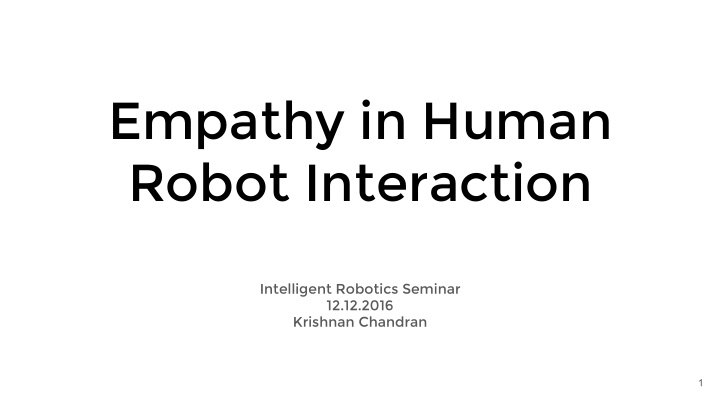



Empathy in Human Robot Interaction Intelligent Robotics Seminar 12.12.2016 Krishnan Chandran 1
Structure of the Presentation ● Motivation ● Definitions ● Neural Basis ● Human Robot Feedback Loop ● Efforts in Robotics ● Commercial examples ● Conclusion & Remarks 2
Motivation “What I cannot create, I do not understand” - Richard Feynman ● Empathy as a biological advantage in evolution. ● A comprehensive overview of Empathy in Human Robot Interactions. ● Empathy as an emergent behavior 3
Meat Machines A term coined by Marvin Minksy. ● Thoughts,Feelings, Hopes, Emotions as operations of the brain. ● Rejects the idea that mind stems from the immaterial. ● Helps in developing computational models. 4
Defining Empathy Cognitive Empathy ● Capacity to understand mental states Affective Empathy ● Capacity to respond to mental states [1] 5
Elements of Empathy Cognitive Empathy ● Recognize an emotional state. ● Theory of mind. ● Mind is not observable. [2] 6
Elements of Empathy Affective Empathy ● Emotional contagion. ● Mimicry ● Emotional Convergence. [2] 7
Empathy in the Brain ● Neural Basis of Empathy ● Insular Cortex - Anterior Insula and Anterior Cingulate Cortex ● Mirror Neurons 8
Empathy in the Brain ● Neural Basis of Empathy ● Insular Cortex - Anterior Insula and Anterior Cingulate Cortex ● Mirror Neurons ● Ventromedial prefrontal cortex [3] 9
A Recipe for creating empathy Model the Mirror Neuron system Model the Insula Model the internal feeling. [5] 10
An Empathetic Human Robot Feedback Loop ● Begins with the Human. ● Anthropomorphic Design. ● Embodiment & Communication ● Expression & Gestures 11
Overcoming the Uncanny Valley ● Reducing the near perfect human likeness of the robot. ● Fluent Display of emotions in robots. ● Computationally expensive. [4] 12
Early efforts in Robotics Kizmet by Cynthia Brezeal, MIT ● Classes of affective intent: approval, prohibition, attention, comfort, and neutral. ● Auditory system ● Visual System ● Vocalization System [2] 13
Towards an Empathy Engine ● Zara, an empathetic android ● Developed in Hong Kong. ● Integrates Facial features, Speech tones and language inputs. ● Uses a recurrent neural network to preserve the memory ● Emotion and intent expression capability. 14
Deep Learning for empathy engine. [7] 15
Long Short Term Memory - RNN ● Extension of Recurrent Neural Networks. ● The Problem of Long-Term Dependencies [9] 16
Long Short Term Memory - RNN ● Extension of Recurrent Neural Networks. ● The Problem of Long-Term Dependencies ● Process data that has periodic patterns. [9] 17
SIRE Model ● Inspired by development in children ● Modality Independent Representation ● Tries to find “universals” across emotional states ● Maps High Level perceptual features to Low Level features ● Speed, Intensity, Regularity and Extent [4] 18
MEI - Multimodal Emotional Intelligence ● Mei Mei Robot ● Three significant characteristics: a recognition ability, an interpretable model, and an expression ability. ● overall crossmodal recognition rate is 63% ● explicit theory for robot development of emotional intelligence through expressive facial and vocal interaction with a caregiver. [4] 19
MEI - Multimodal Emotional Intelligence ● Mei Mei Robot ● Three significant characteristics: a recognition ability, an interpretable model, and an expression ability. ● overall crossmodal recognition rate is 63% ● explicit theory for robot development of emotional intelligence through expressive facial and vocal interaction with a caregiver. [4] 20
Pepper by Softbank Robotics ● Commercially available robot. ● SDK available for Android. ● Uses proprietary algorithm. ● Choreographe, a software for a programming Pepper. [10] 21
Pepper by Softbank Robotics ● Commercially available robot. ● SDK available for Android. ● Uses proprietary algorithm. ● Choreographe, a software for a programming Pepper. [11] 22
Conclusion ● Standardized Empathy learning Engine for social robots. ● Modality independence. ● Far from a commercially viable empathetic robot. ● Does not consider Limbic system. 23
Remarks ● What is authentic empathy? ● Empathy model’s believability. ● Ethical concerns of embedding robots with with abstract layers of intelligence. ● Effect on Human Empathy development. ● Cognitive Offloading: If we don’t exercise a mental faculty, it will become extinct. ● Empathy is not the enemy of reason, rather it helps us assign value. ● Ethnocultural empathy 24
References [1] http://labs.sogeti.com/empathic-things-humanoid-robot-understands-emotions/ [2] http://blog.teleosleaders.com/2013/07/19/emotional-empathy-and-cognitive-empathy [3]http://www.slideshare.net/ElodiBodamer/the-insular-cortexelodi-bodamer-goa-class [4]http://spectrum.ieee.org/automaton/robotics/humanoids/the-uncanny-valley [5]Lim, A. & Okuno, H.G. Int J of Soc Robotics (2015) 7: 35. doi:10.1007/s12369-014-0262-y [6] https://en.wikipedia.org/wiki/Kismet_(robot) [7]Fung, Pascale; Bertero, Dario; Wan, Yan; Dey, Anik; Chan, Ricky Ho Yin; Siddique, Farhad Bin; Yang, Yang; Wu, Chien-Sheng; Lin, Ruixi .Towards Empathetic Human-Robot Interactions [8]Rizzolatti, Giacomo; Craighero, Laila (2004). "The mirror-neuron system" Annual Review of Neuroscience. 27 (1): 169–192. [9]http://colah.github.io/posts/2015-08-Understanding-LSTMs [10]http://www.softbank.jp/en/robot/ [11]https://www.youtube.com/watch?v=SupXHWZ5kcs 25
Questions? 26
Recommend
More recommend